Our
preliminary task was to film and edit a sequence that would show a character
going into a room and having a short conversation with another. The 180˚ rule,
match on action, shot reverse shot and continuity were all aspects that we had
to establish in the clip.
I think that
one of the strengths of our sequence was our large variety of shots. This is
the opening, which begins as a mid-shot and ends as a long shot as the
character walks further down the corridor. I think it is an effective opening
because the shot is composed so that the girl is positioned in the centre, with
quite plain surroundings meaning that she is the focal point, and therefore a
significant part of the film. One of the parts we could improve upon would be the
steadiness of the camera. In the shot above, the camera would jump slightly as
the actor was walking. We would have to practise and find ways of this not
affecting the camera, perhaps holding or weighing the camera down firmly. We
did use some varied camera angles, as some high angled shots are featured later
when the coin is pushed across the table. However, I still think that there was
room to improve on this by being more adventurous with the angles, and ensuring
that sometimes they symbolised something, perhaps showing which character has
power or is more superior, or maybe to give an atmosphere of being watched.
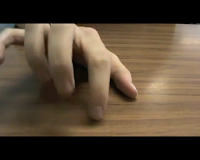
This a contrasting type of shot that we employed for the opening of the sequence, and demonstrates the wide range of shots that we used. It is very different to the first shot as it is a close-up. I think that this is an interesting shot because the hand is slightly off-centre, dissimilarly to the previous one, where our focus was in the middle. This shot also links to the editing of our piece, as it is a cutaway- another part of the story occurring at the same time in a different place. It also builds tension, as we see
it three times, and I think that the repetition makes the viewer apprehensive and edgy.
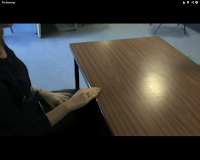
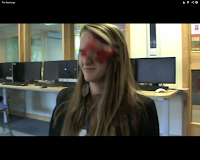 I was very pleased with how this part of the sequence turned
out because of the editing. We had two separate shots of the coin being dragged
across the desk from different angles, and managed to edit it so that they ran
smoothly into each other, and this is a good example of match on action. The
moment straight after this- when a bag of Skittles is thrown at the character’s
face- is also an example of editing in our clip that I am very pleased with. We
had a shot of the bag being thrown, and then another shot of it hitting the
character on the forehead. I think this also runs smoothly, as the height that
the bag was thrown at matches the next part when it is moving towards her face-
another example of match on action.
I was very pleased with how this part of the sequence turned
out because of the editing. We had two separate shots of the coin being dragged
across the desk from different angles, and managed to edit it so that they ran
smoothly into each other, and this is a good example of match on action. The
moment straight after this- when a bag of Skittles is thrown at the character’s
face- is also an example of editing in our clip that I am very pleased with. We
had a shot of the bag being thrown, and then another shot of it hitting the
character on the forehead. I think this also runs smoothly, as the height that
the bag was thrown at matches the next part when it is moving towards her face-
another example of match on action. This is also seen when the girl pushes the door handle down, and in the next shot we see her entering the room. This is because you see that she is using the same hand on the door that she did in the previous shot.
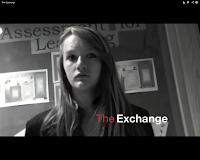
Other parts of the editing that were successful was the shot transition that we used. I thought it was effective as it gave the impression that a few moments had passed. We decided to only use one transition, as it was quite a short sequence, and to use more would be needless and over the top. Just as the title comes on, the shot turns black and white which looks quite dramatic so is suitable for the tone of the film. I think that the title is also appropriate, as it is in red and white, and in front of the black and white background it is eye-catching.
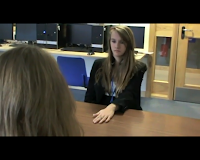
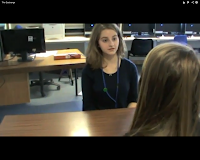 These
are our examples of shot reverse shot. We used this with over the shoulder
shots when the characters were having a short conversation. Looking at these
shots you can also see how we have followed the 180˚ rule. The camera would
only stay on one end of the desk in order to stick to the rule, and I think
that this helped to make our sequence look more professional.
These
are our examples of shot reverse shot. We used this with over the shoulder
shots when the characters were having a short conversation. Looking at these
shots you can also see how we have followed the 180˚ rule. The camera would
only stay on one end of the desk in order to stick to the rule, and I think
that this helped to make our sequence look more professional.
I
think that lighting is something we could have done more with, by experimenting
with other lighting states. However, I
was happy with the lighting in the first shot because it is very well-lit, and
then a few moments later we see two shots of the character’s feet, and the
lighting here is a little darker, and you can see more shadows-especially in
the part when the camera is lifted up- which I think makes it quite an intense moment.
Through
the experience of our preliminary task I have learnt the significance of the
preparation. The shot list and storyboard were important in maintaining
continuity and ensuring that the times we used match on action would be
correct. These will help us also when making our thriller because it will look
professional. For this task I learnt how to use iMovie for when we edited the
film. It was useful to learn about how to change the length of shots, insert
transitions, put in titles and so on. A valuable lesson that we learned from
the task was to film shots quite a few times, so that there is plenty of choice
for editing.
When
making the thriller, I think that the most important things to improve on are
the steadiness of the camera and the lighting states. Having more varied
lighting will give different moods for various parts of the film. Another thing
that we could experiment with would be the camera angles, as these can be used
to symbolise different ideas and make the dynamics more varied.

Well doen Mia - you have produced a prelim that demonstrates proficiency with the camera skills and editing - a grade C roughly. Editing is stronger - now focus on your camera skills - focus on composition and framing; also ensuring stead shots / movement - practise with the tripod.
ReplyDeleteYou write skillfully about your work, using terminology accurately and fully. You have a clear sense of your skills and areas for developement.
Your blog is looking good - make sure that you fully evidence all your research and planning actiivites as we progress to reach and excellent level.
Well done!